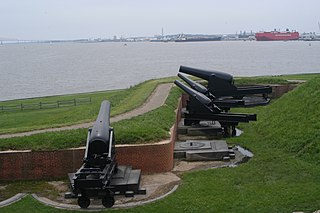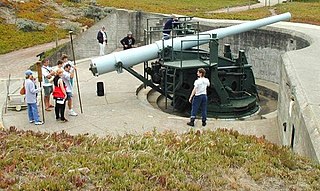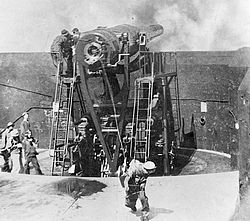
Fort Adams is a former United States Army post in Newport, Rhode Island, that was established on July 4, 1799, as a First System coastal fortification, named for President John Adams, who was in office at the time. Its first commanding officer was Captain John Henry who was later instrumental in starting the War of 1812. The current Fort Adams was built between 1824 and 1857 under the Third System of coastal forts; it is part of Fort Adams State Park today.

Joint Expeditionary Base-Fort Story, commonly called simply Fort Story is a sub-installation of Joint Expeditionary Base Little Creek–Fort Story, which is operated by the United States Navy. Located in the independent city of Virginia Beach, Virginia at Cape Henry at the entrance of the Chesapeake Bay, it offers a unique combination of features including dunes, beaches, sand, surf, deep-water anchorage, variable tide conditions, maritime forest and open land. The base is the prime location and training environment for both U.S. Army amphibious operations and Joint Logistics-Over-the-Shore (LOTS) training events.

Fort Hancock is a former United States Army fort at Sandy Hook in Atlantic Highlands New Jersey. The coastal artillery base defended the Atlantic coast and the entrance to New York Harbor, with its first gun batteries operational in 1896. The fort served from then until 1950 as part of the Harbor Defenses of New York and predecessor organizations. Between 1874 and 1919, the adjacent US Army Sandy Hook Proving Ground was operated in conjunction with Fort Hancock. It is now part of Fort Hancock Memorial Park. It was preceded by the Fort at Sandy Hook, built 1857–1867 and demolished beginning in 1885.

Fort Mott, located in Pennsville, Salem County, New Jersey, United States, was part of the Harbor Defenses of the Delaware, a three-fort defense system designed for the Delaware River during the Reconstruction era and Endicott program modernization periods following the American Civil War and in the 1890s. The other two forts in the system were Fort Delaware on Pea Patch Island and Fort DuPont in Delaware City, Delaware. It was active for the Spanish American War and World War I. It was closed in 1944, and sold to the state of New Jersey to become Fort Mott State Park.

Dutch Island is an island lying west of Conanicut Island at an entrance to Narragansett Bay in Rhode Island, United States. It is part of the town of Jamestown, Rhode Island, and has a land area of 0.4156 km². It was uninhabited as of the United States Census, 2000. The island was fortified from the American Civil War through World War II and was known as Fort Greble from 1898 to 1947.

Beavertail State Park is a public recreation area encompassing 153 acres (62 ha) at the southern end of Conanicut Island in Narragansett Bay, Rhode Island. The state park's main attraction is the active Beavertail Lighthouse, the current tower of which dates from 1856. During World War II, the park area was part of Fort Burnside, one of several coastal fortifications designed to protect Narragansett Bay. The park's scenic shoreline offers hiking, picnicking, and saltwater fishing.

Fort Baldwin is a former coastal defense fortification near the mouth of the Kennebec River in Phippsburg, Maine, United States, preserved as the Fort Baldwin State Historic Site. It was named after Jeduthan Baldwin, an engineer for the Continental Army during the American Revolution. The site was listed on the National Register of Historic Places in 1979.

Seacoast defense was a major concern for the United States from its independence until World War II. Before airplanes, many of America's enemies could only reach it from the sea, making coastal forts an economical alternative to standing armies or a large navy. After the 1940s, it was recognized that fixed fortifications were obsolete and ineffective against aircraft and missiles. However, in prior eras foreign fleets were a realistic threat, and substantial fortifications were built at key locations, especially protecting major harbors.

Fort Wetherill is a former coast artillery fort that occupies the southern portion of the eastern tip of Conanicut Island in Jamestown, Rhode Island. It sits atop high granite cliffs, overlooking the entrance to Narragansett Bay. Fort Dumpling from the American Revolutionary War occupied the site until it was built over by Fort Wetherill. Wetherill was deactivated and turned over to the State of Rhode Island after World War II and is now operated as Fort Wetherill State Park, a 51-acre (210,000 m2) reservation managed by the Rhode Island Department of Environmental Management.

Fort Levett was a former U.S. Army fort built on Cushing Island, Maine, beginning in 1898. Located in Cumberland County, Maine, in Casco Bay near Portland, Maine, the fort was heavily fortified with guns for coastal defense. Conceived under the Endicott Program in 1885 and begun in the wake of the Spanish–American War, Fort Levett was manned during both world wars. It was part of the Coast Defenses of Portland, later renamed the Harbor Defenses of Portland, a command which protected Portland's port and naval anchorage from 1904 to 1950. The fort's name is sometimes misspelled "Leavitt".

The 12-inch coastal defense gun M1895 (305 mm) and its variants the M1888 and M1900 were large coastal artillery pieces installed to defend major American seaports between 1895 and 1945. For most of their history they were operated by the United States Army Coast Artillery Corps. Most were installed on disappearing carriages, with early installations on low-angle barbette mountings. From 1919, 19 long-range two-gun batteries were built using the M1895 on an M1917 long-range barbette carriage. Almost all of the weapons not in the Philippines were scrapped during and after World War II.

The 10-inch Gun M1895 (254 mm) and its variants the M1888 and M1900 were large coastal artillery pieces installed to defend major American seaports between 1895 and 1945. For most of their history they were operated by the United States Army Coast Artillery Corps. Most were installed on disappearing carriages, with early installations on barbette mountings. All of the weapons not in the Philippines were scrapped during World War II. Two of the surviving weapons were relocated from the Philippines to Fort Casey in Washington state in the 1960s.

The 6-inch gun M1897 (152 mm) and its variants the M1900, M1903, M1905, M1908, and M1 were coastal artillery pieces installed to defend major American seaports between 1897 and 1945. For most of their history they were operated by the United States Army Coast Artillery Corps. They were installed on disappearing carriages or pedestal mountings, and during World War II many were remounted on shielded barbette carriages. Most of the weapons not in the Philippines were scrapped within a few years after World War II.

Fort Church was a World War II United States Army coastal defense fort in Little Compton, Rhode Island. Together with Fort Greene near Point Judith, it superseded all previous heavy gun defenses in the Harbor Defenses of Narragansett Bay.

Fort Greene is a United States Army Reserve installation in the Point Judith area of Narragansett, Rhode Island. During World War II this was a coastal defense fort, and together with Fort Church in Little Compton, it superseded all previous heavy gun defenses in the Harbor Defenses of Narragansett Bay. It is named for General Nathanael Greene of the Revolutionary War, who was born in Rhode Island.

Camp Varnum is a Rhode Island Army National Guard training facility in the Boston Neck area of Narragansett, Rhode Island. During World War II it was Fort Varnum, a coastal defense fort.

Fort Kearny was a coastal defense fort in the Saunderstown area of Narragansett, Rhode Island from 1901 to 1943. It was a prisoner-of-war camp for German prisoners in 1945. It is now the Narragansett Bay Campus of the University of Rhode Island. In many sources it is spelled Fort Kearney.

The 5-inch gun M1897 (127 mm) and its variant the M1900 were coastal artillery pieces installed to defend major American seaports between 1897 and 1920. For most of their history they were operated by the United States Army Coast Artillery Corps. They were installed on balanced pillar or pedestal mountings; generally the M1897 was on the balanced pillar mounting and the M1900 was on the pedestal mounting. All of these weapons were scrapped within a few years after World War I.

The Harbor Defenses of Narragansett Bay was a United States Army Coast Artillery Corps harbor defense command. It coordinated the coast defenses of Narragansett Bay and Rhode Island from 1895 to 1950, beginning with the Endicott program. These included both coast artillery forts and underwater minefields. The command originated circa 1895 as an Artillery District, was renamed Coast Defenses of Narragansett Bay in 1913, and again renamed Harbor Defenses of Narragansett Bay in 1925.
The 243rd Coast Artillery Regiment was a Coast Artillery Corps regiment in the Rhode Island National Guard. It garrisoned the Harbor Defenses of Narragansett Bay, Rhode Island 1924–1944.





















